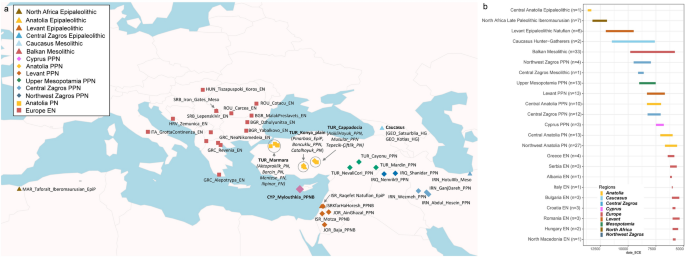Tautalus
Regular member
- Messages
- 239
- Reaction score
- 266
- Points
- 63
- Ethnic group
- Portuguese
- Y-DNA haplogroup
- I2-M223 / I-FTB15368
- mtDNA haplogroup
- H6a1b2
Abstract
Archaeological evidence supports sporadic seafaring visits to the Eastern Mediterranean island of Cyprus by Epipaleolithic hunter-gatherers over 12,000 years ago, followed by permanent settlements during the early Neolithic. The geographical origins of these early seafarers have so far remained elusive. By systematically analysing all available genomes from the late Pleistocene to early Holocene Near East (c. 14,000–7000 cal BCE), we provide a comprehensive overview of the genetic landscape of the early Neolithic Fertile Crescent and Anatolia and infer the likely origins of three recently published genomes from Kissonerga-Mylouthkia (Cypriot Late Pre-Pottery Neolithic B, c. 7600–6800 cal BCE). These appear to derive roughly 80% of their ancestry from Aceramic Neolithic Central Anatolians residing in or near the Konya plain, and the remainder from a genetically basal Levantine population. Based on genome-wide weighted ancestry covariance analysis, we infer that this admixture event took place roughly between 14,000 and 10,000 BCE, coinciding with the transition from the Cypriot late Epipaleolithic to the Pre-Pottery Neolithic A (PPNA). Additionally, we identify strong genetic affinities between the examined Cypro-LPPNB individuals and later northwestern Anatolians and the earliest European Neolithic farmers. Our results inform archaeological evidence on prehistoric demographic processes in the Eastern Mediterranean, providing important insights into early seafaring, maritime connections, and insular settlement.
PCA plot displaying all ancient samples analysed in the present study.

Archaeological evidence supports sporadic seafaring visits to the Eastern Mediterranean island of Cyprus by Epipaleolithic hunter-gatherers over 12,000 years ago, followed by permanent settlements during the early Neolithic. The geographical origins of these early seafarers have so far remained elusive. By systematically analysing all available genomes from the late Pleistocene to early Holocene Near East (c. 14,000–7000 cal BCE), we provide a comprehensive overview of the genetic landscape of the early Neolithic Fertile Crescent and Anatolia and infer the likely origins of three recently published genomes from Kissonerga-Mylouthkia (Cypriot Late Pre-Pottery Neolithic B, c. 7600–6800 cal BCE). These appear to derive roughly 80% of their ancestry from Aceramic Neolithic Central Anatolians residing in or near the Konya plain, and the remainder from a genetically basal Levantine population. Based on genome-wide weighted ancestry covariance analysis, we infer that this admixture event took place roughly between 14,000 and 10,000 BCE, coinciding with the transition from the Cypriot late Epipaleolithic to the Pre-Pottery Neolithic A (PPNA). Additionally, we identify strong genetic affinities between the examined Cypro-LPPNB individuals and later northwestern Anatolians and the earliest European Neolithic farmers. Our results inform archaeological evidence on prehistoric demographic processes in the Eastern Mediterranean, providing important insights into early seafaring, maritime connections, and insular settlement.

Palaeogenomic insights into the origins of early settlers on the island of Cyprus - Scientific Reports
Archaeological evidence supports sporadic seafaring visits to the Eastern Mediterranean island of Cyprus by Epipaleolithic hunter-gatherers over 12,000 years ago, followed by permanent settlements during the early Neolithic. The geographical origins of these early seafarers have so far remained...www.nature.com
PCA plot displaying all ancient samples analysed in the present study.

Last edited:


